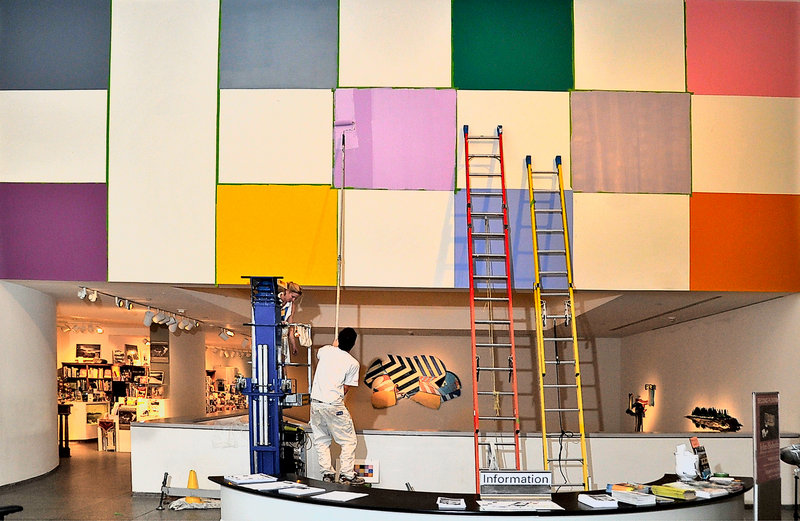Mark Wethli made a painting in 2003. Seven years later, another artist had a different idea for the use of Wethli’s “canvas,” and the original was painted over.
The folks who commissioned Wethli’s original painting decided they liked it so much, they hired someone else to replicate it, using the same colors and even the same surface.
Does that make the new painting an original or a copy?
The painting in question is “Transom,” which Wethli created as part of the 2003 biennial of the Portland Museum of Art. He made a colorful, evocative grid painting on the facing wall of the Great Hall. It was the first thing most people saw when they entered the museum, a pattern of color-block grids, each roughly 16 feet square.
Wethli always intended the painting to be temporary — it was to be painted over when the biennial closed. Instead it remained, because people loved it. So what was supposed to be a temporary installation became the centerpiece of the Great Hall.
This past summer, when Anna Hepler installed her giant ceiling-suspended installation that she cleverly titled “The Great Haul,” the museum painted over Wethli’s “Transom,” returning the wall to its original shade of white.
And now that Hepler’s piece has been removed, the Wethli painting is back up.
Only this time, Wethli didn’t paint it.
Wethli, who teaches at Bowdoin College, dismisses the idea that the new version of “Transom” is not original. He mixed the colors for the new painting last weekend, and left the museum specific instructions for its reinstallation when he made the original and later offered it to the museum as a gift.
“This work is designed in such a way that anyone who is skillful in painting can realize the work,” Wethli said this week.
His opinion is supported by the work of a generation of conceptual artists, most famously Sol LeWitt. LeWitt’s genius was sitting at a table and coming up with geometric ideas and color patterns that he liked. He prepared a sketch to document his ideas, and then transferred the rights to someone else, along with notes and measures.
When you purchased a LeWitt, you didn’t receive a physical work of art, but a folder full of colors, numbers and designs, said the PMA’s chief curator, Thomas Denenberg.
“LeWitt had every expectation that his works would come off the wall, and be repurposed. ‘Transom’ is no different,” he said.
As for its hands-on authenticity, Wethli was involved in the new version of his painting. He didn’t apply the paint to the wall himself, but he did mix the colors, noted Susan Danly, the museum’s curator of contemporary art. Those colors are not simple colors that are easily available. Each is unique, a direct result of Wethli’s decision-making process and color sensibilities.
“Mark still had a hand and played an active role in selecting the paint and colors and putting it back up again,” Danly said. “It’s not the original, no. But it is original in the sense that the concept is the same, the range of colors is the same.
“But there are subtle differences. The work changes a bit, but that always happens with installation pieces. It’s never quite the same.”
If it were precisely the same, then it would be a reproduction. The new “Transom” definitely is not a reproduction. Because Wethli participated in the process and has been involved from the get-go, the new painting has the authority of the original.
The vast majority of visitors will not detect differences between the 2010 version of “Transom” and the 2003 version. The lines separating the colors may be slightly different, and perhaps the precise color tones will be a smidge off. Those subtleties make the new painting original in its own way.
Wethli is pleased with the return of “Transom.”
“It was not meant to be permanent. But happily, it seems to have grown on people,” he said. “It’s delightful to me that it is reinstalled, and I am proud to have it there. When people first visit the museum, it is one of their first strong impressions. It’s great.”
Wethli quickly added that he was equally happy that it came down to accommodate Hepler’s installation. “It was always meant to live there in an organic way,” he said.
A few other “Transom” facts:
• Wethli created a color study for the first “Transom” with the same paint that ended up on the wall. He gave the museum the study in memory of his friend, Sumner Bernstein. Bernstein’s widow, Roz, is a member of the museum’s board and chairman of the collection committee.
• There are 21 colors in the piece, and although each block looks square, they are not exactly square.
• Building designer Henry Cobb always intended for the wall that houses “Transom” to be draped in color. Cobb’s vision included tapestries to hang on the wall, but they were never fabricated.
Staff Writer Bob Keyes can be contacted at 791-6457 or at:
bkeyes@pressherald.com
Copy the Story Link
Send questions/comments to the editors.




Success. Please wait for the page to reload. If the page does not reload within 5 seconds, please refresh the page.
Enter your email and password to access comments.
Hi, to comment on stories you must . This profile is in addition to your subscription and website login.
Already have a commenting profile? .
Invalid username/password.
Please check your email to confirm and complete your registration.
Only subscribers are eligible to post comments. Please subscribe or login first for digital access. Here’s why.
Use the form below to reset your password. When you've submitted your account email, we will send an email with a reset code.